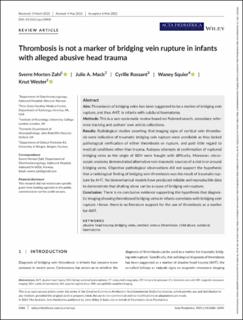| dc.contributor.author | Zahl, Sverre Morten | |
| dc.contributor.author | Mack, Julie A. | |
| dc.contributor.author | Rossant, Cyrille | |
| dc.contributor.author | Squier, Waney | |
| dc.contributor.author | Wester, Knut | |
| dc.date.accessioned | 2021-08-17T06:23:14Z | |
| dc.date.available | 2021-08-17T06:23:14Z | |
| dc.date.created | 2021-06-21T17:56:26Z | |
| dc.date.issued | 2021 | |
| dc.identifier.issn | 0803-5253 | |
| dc.identifier.uri | https://hdl.handle.net/11250/2768656 | |
| dc.description.abstract | Aim: Thrombosis of bridging veins has been suggested to be a marker of bridging vein rupture, and thus AHT, in infants with subdural haematoma.
Methods: This is a non-systematic review based on Pubmed search, secondary reference tracking and authors’ own article collections.
Results: Radiological studies asserting that imaging signs of cortical vein thrombosis were indicative of traumatic bridging vein rupture were unreliable as they lacked pathological verification of either thrombosis or rupture, and paid little regard to medical conditions other than trauma. Autopsy attempts at confirmation of ruptured bridging veins as the origin of SDH were fraught with difficulty. Moreover, microscopic anatomy demonstrated alternative non-traumatic sources of a clot in or around bridging veins. Objective pathological observations did not support the hypothesis that a radiological finding of bridging vein thrombosis was the result of traumatic rupture by AHT. No biomechanical models have produced reliable and reproducible data to demonstrate that shaking alone can be a cause of bridging vein rupture.
Conclusion: There is no conclusive evidence supporting the hypothesis that diagnostic imaging showing thrombosed bridging veins in infants correlates with bridging vein rupture. Hence, there is no literature support for the use of thrombosis as a marker for AHT. | en_US |
| dc.language.iso | eng | en_US |
| dc.publisher | Wiley | en_US |
| dc.rights | Attribution-NonCommercial-NoDerivatives 4.0 Internasjonal | * |
| dc.rights.uri | http://creativecommons.org/licenses/by-nc-nd/4.0/deed.no | * |
| dc.title | Thrombosis is not a marker of bridging vein rupture in infants with alleged abusive head trauma | en_US |
| dc.type | Journal article | en_US |
| dc.type | Peer reviewed | en_US |
| dc.description.version | publishedVersion | en_US |
| dc.rights.holder | Copyright 2021 The Authors. | en_US |
| cristin.ispublished | true | |
| cristin.fulltext | original | |
| cristin.qualitycode | 1 | |
| dc.identifier.doi | 10.1111/apa.15908 | |
| dc.identifier.cristin | 1917496 | |
| dc.source.journal | Acta Paediatrica | en_US |
| dc.source.pagenumber | 2686-2694 | |
| dc.identifier.citation | Acta Paediatrica. 2021, 110 (10), 2686-2694. | en_US |
| dc.source.volume | 110 | |
| dc.source.issue | 10 | |

